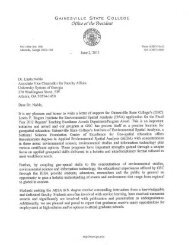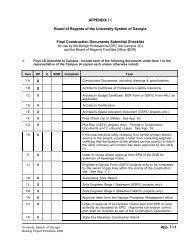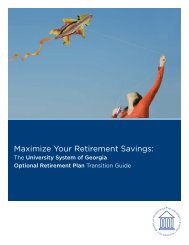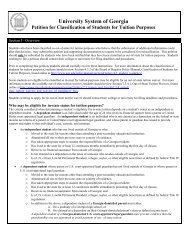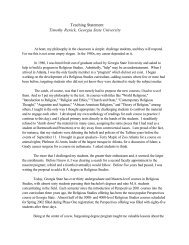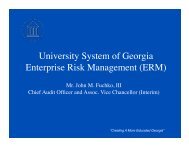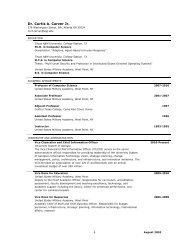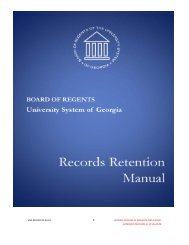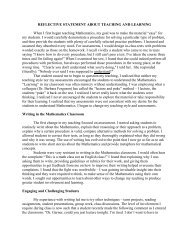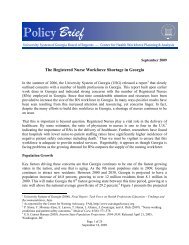WReier-Aviles on DSKGBLS3C1PROD with RULES266934 Federal Register / Vol. 75, No. 209 / Friday, October 29, 2010 / Rules and Regulationsand the amount from institutionalfinancing plans that the student owesthe institution after completing theprogram, and whether the studentmatriculated to a higher credentialedprogram at the same or anotherinstitution will average .08 hours (5minutes) per student or 26,033 hours <strong>of</strong>increased burden for the 2009–2010award year.We estimate that 33,627 <strong>of</strong> the567,334 students will complete theirprogram at a private not-for-pr<strong>of</strong>itinstitution. We estimate that thereporting <strong>of</strong> student identifierinformation, the location <strong>of</strong> theinstitution the student attended, the CIPcodes for each graduate, the date <strong>of</strong>completion, the amounts the studentreceived from private education loansand the amount from institutionalfinancing plans that the student owesthe institution after completing theprogram, and whether the studentmatriculated to a higher credentialedprogram at the same or anotherinstitution will average .08 hours (5minutes) per student or 2,690 hours <strong>of</strong>increased burden during the 2009–2010award year.We estimate that 208,291 <strong>of</strong> the567,334 students will complete theirprogram at a public institution duringthe 2009–2010 award year. We estimatethat the reporting <strong>of</strong> student identifierinformation, the location <strong>of</strong> theinstitution the student attended, the CIPcodes for each graduate, the date <strong>of</strong>completion, the amounts the studentreceived from private education loansand the amount from institutionalfinancing plans that the student owesthe institution after completing theprogram, and whether the studentmatriculated to a higher credentialedprogram at the same or anotherinstitution will average .08 hours (5minutes) per student or 16,663 hours <strong>of</strong>increased burden for the 2009–2010award year.Collectively, we estimate that burdenfor institutions to meet these reportingrequirements for students who beginattendance or complete theiroccupational programs that trainstudents for gainful employment in arecognized occupation will increaseburden by 658,758 hours in OMBControl Number 1845–NEW1.Finally, under § 668.6(b) aninstitution will be required to discloseto each prospective student informationabout (1) The occupations (by namesand Standard Occupational Code (SOC)codes) that its programs preparestudents to enter, along with links tooccupational pr<strong>of</strong>iles on O*NET or itssuccessor site, or if the number <strong>of</strong>occupations related to the program onO*Net is more than ten (10), theinstitution may provide Web links to arepresentative sample <strong>of</strong> SOC codes forwhich its graduates typically findemployment within a few years aftercompleting their program; (2) the ontimegraduation rate for studentsentering the program; (3) the totalamount <strong>of</strong> tuition and fees it charges astudent for completing the programwithin normal time as defined in§ 668.41(a), the typical costs for booksand supplies, and the cost <strong>of</strong> room andboard, if applicable. The institution mayinclude information on other costs, suchas transportation and living expenses,but it must provide a Web link, oraccess, to the program cost informationthe institution makes available under§ 668.43(a); (4) beginning on July 1,2011, the placement rate for studentscompleting the program, as determinedunder the institution’s accreditingagency or State requirements, until anew placement rate methodology isdeveloped by the National Center for<strong>Education</strong> Statistics (NCES) andreported to the institution; and (5) themedian loan debt incurred by studentswho completed the program as providedby the Secretary, as well as any otherinformation the Secretary provided tothe institution about that program. Theinstitution must identify separately themedian loan debt from title IV, HEAprograms and the median loan debtfrom private educational loans andinstitutional financing plans.We estimate that <strong>of</strong> the 5,601institutions with these occupationalprograms that 1,950, or 35%, areproprietary institutions. We estimatethat <strong>of</strong> the 5,601 with theseoccupational programs that 1,736, or31%, are private not-for-pr<strong>of</strong>itinstitutions. We estimate that <strong>of</strong> the5,601 with these occupational programsthat 1,915, or 34%, are publicinstitutions. Because under the reviseddisclosure requirements, institutionsmay use a representative sample <strong>of</strong> SOCcodes and use placement rate dataalready required by their accreditingagency or State, or data that will beprovided by the <strong>Department</strong>, weestimate that on average, it will take 1.5hours for an institution to obtain therequired disclosure information fromO*Net and its own programmatic costinformation and to provide thatinformation on its Web site and in itspromotional materials. Therefore, weestimate that burden for 1,950proprietary institutions will increase by2,925 hours. We estimate that burdenfor 1,736 private not-for-pr<strong>of</strong>itinstitutions will increase by 2,604hours. We estimate that burden forVerDate Mar2010 14:10 Oct 28, 2010 Jkt 223001 PO 00000 Frm 00104 Fmt 4701 Sfmt 4700 E:\FR\FM\29OCR2.SGM 29OCR21,915 public institutions will increaseby 2,873 hours.Collectively, we estimate that burdenfor institutions to meet these disclosurerequirements for prospective studentswill increase burden by 8,402 hours inOMB Control Number 1845–NEW1.We estimate the total burden underthis section to increase by 677,160 hoursin OMB Control Number 1845–NEW1.Section 668.8—Eligible ProgramUnder S668.8(l)(1), we will revise themethod <strong>of</strong> converting clock hours tocredit hours to use a ratio <strong>of</strong> theminimum clock hours in an academicyear to the minimum credit hours in anacademic year, i.e., 900 clock hours to24 semester or trimester hours or 36quarter hours. Thus, a semester ortrimester hour will be based on at least37.5 clock hours, and a quarter hourwill be based on at least 25 clock hours.Section 668.8(l)(2) will create anexception to the conversion ratio in§ 668.8(l)(1) if neither an institution’sdesignated accrediting agency nor therelevant State licensing authority forparticipation in the title IV, HEAprograms determines there are anydeficiencies in the institution’s policies,procedures, and practices forestablishing the credit hours that theinstitution awards for programs andcourses, as defined in § 600.2. Under theexception provided by § 668.8(l)(2), aninstitution will be permitted to combinestudents’ work outside <strong>of</strong> class with theclock-hours <strong>of</strong> instruction in order tomeet or exceed the numericrequirements established in§ 668.8(l)(1). However, under§ 668.8(l)(2), the institution will need touse at least 30 clock hours for a semesteror trimester hour or 20 clock hours fora quarter hour.In determining whether there isoutside work that a student mustperform, the analysis will need to takeinto account differences in courseworkand educational activities within theprogram. Some portions <strong>of</strong> a programmay require student work outside <strong>of</strong>class that justifies the application <strong>of</strong>§ 668.8(l)(2). In addition, the application<strong>of</strong> § 668.8(l)(2) could vary within aprogram depending on variances inrequired student work outside <strong>of</strong> classfor different portions <strong>of</strong> the program.Other portions <strong>of</strong> the program may nothave outside work, and § 668.8(l)(1) willneed to be applied. Of course, aninstitution applying only § 668.8(l)(1) toa program eligible for conversion fromclock hours to credit hours, without ananalysis <strong>of</strong> the program’s coursework,will be considered compliant with therequirements <strong>of</strong> § 668.8(l).
Federal Register / Vol. 75, No. 209 / Friday, October 29, 2010 / Rules and Regulations66935WReier-Aviles on DSKGBLS3C1PROD with RULES2Section 668.8(k)(1)(ii) will modify aprovision in current regulations toprovide that a program is not subject tothe conversion formula in § 668.8(l)where each course within the programis acceptable for full credit toward adegree that is <strong>of</strong>fered by the institutionand that this degree requires at least twoacademic years <strong>of</strong> study. Additionally,under § 668.8(k)(1)(ii), the institutionwill be required to demonstrate thatstudents enroll in, and graduate from,the degree program.Section 668.8(k)(2)(i) will provide thata program is considered to be a clockhourprogram if the program must bemeasured in clock hours to receiveFederal or State approval or licensure,or if completing clock hours is arequirement for graduates to apply forlicensure or the authorization topractice the occupation that the studentis intending to pursue. Under§ 668.8(k)(2)(ii) and (iii), the programwill also be considered to be <strong>of</strong>fered inclock hours if the credit hours awardedfor the program are not in compliancewith the definition <strong>of</strong> a credit hour in§ 600.2, or if the institution does notprovide the clock hours that are thebasis for the credit hours awarded forthe program or each course in theprogram and, except as provided incurrent § 668.4(e), requires attendancein the clock hours that are the basis forthe credit hours awarded. The finalregulations on which tentativeagreement was reached will not includethe provision in § 668.8(k)(2)(iii) that,except as provided in current § 668.4(e),an institution must require attendancein the clock hours that are the basis forthe credit hours awarded.Section 668.8(k)(3) will provide that§ 668.8(k)(2)(i) will not apply if alimited portion <strong>of</strong> the program includesa practicum, internship, or clinicalexperience component that mustinclude a minimum number <strong>of</strong> clockhours due to a State or Federal approvalor licensure requirement.We estimate that on average, for eachaffected program it will take .5 hours (30minutes) for an institution to make thedetermination <strong>of</strong> whether the program isan affected program, to evaluate theamount <strong>of</strong> outside student work thatshould be included as final and toperform the clock hour to credit hourconversion. We further estimate that <strong>of</strong>the 4,587 institutions <strong>of</strong> highereducation with less than 2-yearprograms, that on average, eachinstitution has approximately 8 nondegreeprograms <strong>of</strong> study for a total <strong>of</strong>36,696 affected programs. We estimatethat there are 16,513 affected programsat proprietary institutions times .5 hours(30 minutes) which will increase burdenby 8,257 hours. We estimate that thereare 1,835 affected programs at privatenon-pr<strong>of</strong>it institutions times .5 hours(30 minutes) which will increase burdenby 918 hours. We estimate that there are18,348 affected programs at publicinstitutions times .5 hours (30 minutes)which will increase burden by 9,174hours.Collectively, the final regulatorychanges reflected in § 668.8 willincrease burden by 18,349 hours inOMB Control Number 1845–0022.Section 668.16—Standards <strong>of</strong>Administrative CapabilityUnder the final regulations, theelements <strong>of</strong> the institution’s satisfactoryacademic progress plan have beenmoved from current § 668.16(e) to§ 668.34. We also have updated theseprovisions. As a result, the estimatedburden upon institutions associatedwith measuring academic progresscurrently in OMB Control Number1845–0022 <strong>of</strong> 21,000 hours will beadministratively removed from thiscollection and transferred to OMBControl Number 1845–NEW2.Under § 668.16(p), an institution willbe required to develop and followprocedures to evaluate the validity <strong>of</strong> astudent’s high school completion if theinstitution or the Secretary has reason tobelieve that the high school diploma isnot valid or was not obtained from anentity that provides secondary schooleducation. The burden associated withthis requirement will be mitigated bythe fact that many institutions alreadyhave processes in place to collect highschool diplomas and makedeterminations about their validity.We estimate that burden will increasefor each institution by 3.5 hours for thedevelopment <strong>of</strong> a high school diplomavalidity process. We estimate that 2,086proprietary institutions will on averagetake 3.5 hours to develop the finalprocedures to evaluate the validity <strong>of</strong>high school completions, which willincrease burden by 7,301 hours. Weestimate that 1,731 private non-pr<strong>of</strong>itinstitutions will on average take 3.5hours to develop the final procedures toevaluate the validity <strong>of</strong> high schoolcompletion, which will increase burdenby 6,059 hours. We estimate that 1,892public institutions will on average take3.5 hours to develop the finalprocedures to evaluate the validity <strong>of</strong>high school completion, which willincrease burden by 6,622 hours.Additionally, we estimate that thevalidity <strong>of</strong> approximately 4,000 highschool diplomas per year will bequestioned and that these diplomas willrequire additional verification, whichwe estimate will take .5 hours (30VerDate Mar2010 14:10 Oct 28, 2010 Jkt 223001 PO 00000 Frm 00105 Fmt 4701 Sfmt 4700 E:\FR\FM\29OCR2.SGM 29OCR2minutes) per questionable diploma. Weestimate that proprietary institutionswill have 2,000 questionable diplomas,which will result in an estimated 1,000hours <strong>of</strong> increased burden (2000diplomas multiplied by .5 hours). Weestimate that private non-pr<strong>of</strong>itinstitutions will have 600 questionablediplomas, which will result in anestimated 300 hours <strong>of</strong> increased burden(600 diplomas multiplied by .5 hours).We estimate that public institutions willhave 1,400 questionable, which willresult in an estimated 700 hours <strong>of</strong>increased burden (1400 diplomasmultiplied by .5 hours).Collectively, the final regulatorychanges reflected in § 668.16 willincrease burden by 21,982 hours inOMB Control Number 1845–0022.Section 668.22—Treatment <strong>of</strong> Title IV,HEA Program Funds When a StudentWithdrawsThe changes to § 668.22(a)(2) clarifywhen a student is considered to havewithdrawn from a payment period orperiod <strong>of</strong> enrollment. In the case <strong>of</strong> aprogram that is measured in credithours, the student will be considered tohave withdrawn if he or she does notcomplete all the days in the paymentperiod or period <strong>of</strong> enrollment that thestudent was scheduled to completeprior to withdrawing. In the case <strong>of</strong> aprogram that is measured in clockhours, the student will be considered tohave withdrawn if he or she does notcomplete all <strong>of</strong> the clock hours in thepayment period or period <strong>of</strong> enrollmentthat the student was scheduled tocomplete prior to withdrawing.Section 668.22(f)(2)(i) clarifies that,for credit hour programs, in calculatingthe percentage <strong>of</strong> the payment period orperiod <strong>of</strong> enrollment completed, it isnecessary to take into account the totalnumber <strong>of</strong> calendar days that thestudent was scheduled to completeprior to withdrawing without regard toany course completed by the studentthat is less than the length <strong>of</strong> the term.These final regulations will affect allprograms with courses that are less thanthe length <strong>of</strong> a term, including, forexample, a semester-based program thathas a summer nonstandard term withtwo consecutive six-week sessionswithin the term.We estimate that approximately425,075 students in term-basedprograms with modules or compressedcourses will withdraw prior tocompleting more than 60 percent <strong>of</strong>their program <strong>of</strong> study. We estimate thaton average, the burden per individualstudent who withdraws prior to the 60percent point <strong>of</strong> their term-basedprogram to be .75 hours (45 minutes)
- Page 1 and 2:
Friday,October 29, 2010Part IIDepar
- Page 3 and 4:
Federal Register / Vol. 75, No. 209
- Page 6 and 7:
66836 Federal Register / Vol. 75, N
- Page 8 and 9:
66838 Federal Register / Vol. 75, N
- Page 10 and 11:
WReier-Aviles on DSKGBLS3C1PROD wit
- Page 12 and 13:
66842 Federal Register / Vol. 75, N
- Page 14 and 15:
66844 Federal Register / Vol. 75, N
- Page 16 and 17:
WReier-Aviles on DSKGBLS3C1PROD wit
- Page 18 and 19:
66848 Federal Register / Vol. 75, N
- Page 20 and 21:
66850 Federal Register / Vol. 75, N
- Page 22 and 23:
WReier-Aviles on DSKGBLS3C1PROD wit
- Page 24 and 25:
66854 Federal Register / Vol. 75, N
- Page 26 and 27:
WReier-Aviles on DSKGBLS3C1PROD wit
- Page 28 and 29:
66858 Federal Register / Vol. 75, N
- Page 30 and 31:
66860 Federal Register / Vol. 75, N
- Page 32 and 33:
66862 Federal Register / Vol. 75, N
- Page 34 and 35:
66864 Federal Register / Vol. 75, N
- Page 36 and 37:
66866 Federal Register / Vol. 75, N
- Page 38 and 39:
WReier-Aviles on DSKGBLS3C1PROD wit
- Page 40 and 41:
WReier-Aviles on DSKGBLS3C1PROD wit
- Page 42 and 43:
66872 Federal Register / Vol. 75, N
- Page 44 and 45:
WReier-Aviles on DSKGBLS3C1PROD wit
- Page 46 and 47:
WReier-Aviles on DSKGBLS3C1PROD wit
- Page 48 and 49:
WReier-Aviles on DSKGBLS3C1PROD wit
- Page 50 and 51:
66880 Federal Register / Vol. 75, N
- Page 52 and 53:
WReier-Aviles on DSKGBLS3C1PROD wit
- Page 54 and 55: 66884 Federal Register / Vol. 75, N
- Page 56 and 57: 66886 Federal Register / Vol. 75, N
- Page 58 and 59: WReier-Aviles on DSKGBLS3C1PROD wit
- Page 60 and 61: WReier-Aviles on DSKGBLS3C1PROD wit
- Page 62 and 63: WReier-Aviles on DSKGBLS3C1PROD wit
- Page 64 and 65: WReier-Aviles on DSKGBLS3C1PROD wit
- Page 66 and 67: WReier-Aviles on DSKGBLS3C1PROD wit
- Page 68 and 69: WReier-Aviles on DSKGBLS3C1PROD wit
- Page 70 and 71: WReier-Aviles on DSKGBLS3C1PROD wit
- Page 72 and 73: 66902 Federal Register / Vol. 75, N
- Page 74 and 75: WReier-Aviles on DSKGBLS3C1PROD wit
- Page 76 and 77: WReier-Aviles on DSKGBLS3C1PROD wit
- Page 78 and 79: 66908 Federal Register / Vol. 75, N
- Page 80 and 81: WReier-Aviles on DSKGBLS3C1PROD wit
- Page 82 and 83: 66912 Federal Register / Vol. 75, N
- Page 84 and 85: WReier-Aviles on DSKGBLS3C1PROD wit
- Page 86 and 87: 66916 Federal Register / Vol. 75, N
- Page 88 and 89: WReier-Aviles on DSKGBLS3C1PROD wit
- Page 90 and 91: WReier-Aviles on DSKGBLS3C1PROD wit
- Page 92 and 93: WReier-Aviles on DSKGBLS3C1PROD wit
- Page 94 and 95: 66924 Federal Register / Vol. 75, N
- Page 96 and 97: WReier-Aviles on DSKGBLS3C1PROD wit
- Page 98 and 99: 66928 Federal Register / Vol. 75, N
- Page 100 and 101: WReier-Aviles on DSKGBLS3C1PROD wit
- Page 102 and 103: 66932 Federal Register / Vol. 75, N
- Page 106 and 107: 66936 Federal Register / Vol. 75, N
- Page 108 and 109: 66938 Federal Register / Vol. 75, N
- Page 110 and 111: 66940 Federal Register / Vol. 75, N
- Page 112 and 113: 66942 Federal Register / Vol. 75, N
- Page 114 and 115: 66944 Federal Register / Vol. 75, N
- Page 116 and 117: 66946 Federal Register / Vol. 75, N
- Page 118 and 119: WReier-Aviles on DSKGBLS3C1PROD wit
- Page 120 and 121: WReier-Aviles on DSKGBLS3C1PROD wit
- Page 122 and 123: WReier-Aviles on DSKGBLS3C1PROD wit
- Page 124 and 125: 66954 Federal Register / Vol. 75, N
- Page 126 and 127: WReier-Aviles on DSKGBLS3C1PROD wit
- Page 128 and 129: 66958 Federal Register / Vol. 75, N
- Page 130 and 131: 66960 Federal Register / Vol. 75, N
- Page 132 and 133: WReier-Aviles on DSKGBLS3C1PROD wit
- Page 134 and 135: WReier-Aviles on DSKGBLS3C1PROD wit
- Page 136 and 137: WReier-Aviles on DSKGBLS3C1PROD wit
- Page 138 and 139: 66968 Federal Register / Vol. 75, N
- Page 140 and 141: 66970 Federal Register / Vol. 75, N
- Page 142 and 143: 66972 Federal Register / Vol. 75, N
- Page 144 and 145: 66974 Federal Register / Vol. 75, N



